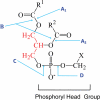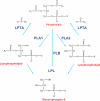Role of phospholipases in fungal fitness, pathogenicity, and drug development - lessons from cryptococcus neoformans
- PMID: 21687772
- PMCID: PMC3109512
- DOI: 10.3389/fmicb.2010.00125
Role of phospholipases in fungal fitness, pathogenicity, and drug development - lessons from cryptococcus neoformans
Abstract
Many pathogenic microbes, including many fungi, produce phospholipases which facilitate survival of the pathogen in vivo, invasion and dissemination throughout the host, expression of virulence traits and evasion of host immune defense mechanisms. These phospholipases are either secreted or produced intracellularly and act by physically disrupting host membranes, and/or by affecting fungal cell signaling and production of immunomodulatory effectors. Many of the secreted phospholipases acquire a glycosylphosphatidylinositol sorting motif to facilitate membrane and/or cell wall association and secretion. This review focuses primarily on the role of two members of the phospholipase enzyme family, phospholipase B (Plb) and phosphatidylinositol (PI)-specific phospholipase C (PI-C/Plc), in fungal pathogenesis and in particular, what has been learnt about their function from studies performed in the model pathogenic yeast, Cryptococcus neoformans. These studies have revealed how Plb has adapted to become an important part of the virulence repertoire of pathogenic fungi and how its secretion is regulated. They have also provided valuable insight into how the intracellular enzyme, Plc1, contributes to fungal fitness and pathogenicity - via a putative role in signal transduction pathways that regulate the production of stress-protecting pigments, polysaccharide capsule, cell wall integrity, and adaptation to growth at host temperature. Finally, this review will address the role fungal phospholipases have played in the development of a new class of antifungal drugs, which mimic their phospholipid substrates.
Keywords: Cryptococcus neoformans; PI-PLC/Plc; drug development; pathogenicity; phosphatidylinositol-specific phospholipase C; phospholipase B; secretion; signaling.
Figures



Similar articles
-
Role and mechanism of phosphatidylinositol-specific phospholipase C in survival and virulence of Cryptococcus neoformans.Mol Microbiol. 2008 Aug;69(4):809-26. doi: 10.1111/j.1365-2958.2008.06310.x. Epub 2008 Jun 4. Mol Microbiol. 2008. PMID: 18532984
-
In vitro antifungal activities of inhibitors of phospholipases from the fungal pathogen Cryptococcus neoformans.Antimicrob Agents Chemother. 2004 May;48(5):1561-9. doi: 10.1128/AAC.48.5.1561-1569.2004. Antimicrob Agents Chemother. 2004. PMID: 15105106 Free PMC article.
-
Extracellular phospholipases as universal virulence factor in pathogenic fungi.Nihon Ishinkin Gakkai Zasshi. 1998;39(2):55-9. doi: 10.3314/jjmm.39.55. Nihon Ishinkin Gakkai Zasshi. 1998. PMID: 9580028 Review.
-
The Transcription Factor Pdr802 Regulates Titan Cell Formation and Pathogenicity of Cryptococcus neoformans.mBio. 2021 Mar 9;12(2):e03457-20. doi: 10.1128/mBio.03457-20. mBio. 2021. PMID: 33688010 Free PMC article.
-
Potential role of phospholipases in virulence and fungal pathogenesis.Clin Microbiol Rev. 2000 Jan;13(1):122-43, table of contents. doi: 10.1128/CMR.13.1.122. Clin Microbiol Rev. 2000. PMID: 10627494 Free PMC article. Review.
Cited by
-
Structural Entities Associated with Different Lipid Phases of Plant Thylakoid Membranes-Selective Susceptibilities to Different Lipases and Proteases.Cells. 2022 Aug 28;11(17):2681. doi: 10.3390/cells11172681. Cells. 2022. PMID: 36078087 Free PMC article.
-
Resolving the pathogenicity factors of a novel opportunistic fungus Schizophyllum commune at molecular level.Mol Biol Rep. 2019 Aug;46(4):3877-3886. doi: 10.1007/s11033-019-04830-7. Epub 2019 Apr 23. Mol Biol Rep. 2019. PMID: 31016617
-
Aimless mutants of Cryptococcus neoformans: failure to disseminate.Fungal Biol Rev. 2012 Oct 1;26(2-3):61-72. doi: 10.1016/j.fbr.2012.02.004. Epub 2012 Mar 30. Fungal Biol Rev. 2012. PMID: 23189087 Free PMC article.
-
Cytological and Gene Profile Expression Analysis Reveals Modification in Metabolic Pathways and Catalytic Activities Induce Resistance in Botrytis cinerea Against Iprodione Isolated From Tomato.Int J Mol Sci. 2020 Jul 9;21(14):4865. doi: 10.3390/ijms21144865. Int J Mol Sci. 2020. PMID: 32660143 Free PMC article.
-
Unravelling secretion in Cryptococcus neoformans: more than one way to skin a cat.Mycopathologia. 2012 Jun;173(5-6):407-18. doi: 10.1007/s11046-011-9468-9. Epub 2011 Sep 6. Mycopathologia. 2012. PMID: 21898146 Review.
References
-
- Alspaugh J. A., Pukkila-Worley R., Harashima T., Cavallo L. M., Funnell D., Cox G. M., Perfect J. R., Kronstad J. W., Heitman J. (2002). Adenylyl cyclase functions downstream of the Galpha protein Gpa1 and controls mating and pathogenicity of Cryptococcus neoformans. Eukaryotic Cell 1, 75–8410.1101/gad.11.23.3206 - DOI - PMC - PubMed
LinkOut - more resources
Full Text Sources
Research Materials
Miscellaneous

